
The Mexican tetra, also known as the blind cave fish, blind cave characin, and blind cave tetra, is a freshwater fish of the family Characidae of the order Characiformes. The type species of its genus, it is native to the Nearctic realm, originating in the lower Rio Grande and the Neueces and Pecos Rivers in Texas, as well as the central and eastern parts of Mexico.

Characidae, the characids or characins, is a family of freshwater subtropical and tropical fish belonging to the order Characiformes. The name "characins" is an historical one, but scientists today tend to prefer "characids" to reflect their status as a, by and large, monophyletic group. To arrive there, this family has undergone much systematic and taxonomic change. Among those fishes remaining in the Characidae currently are the tetras, comprising the very similar genera Hemigrammus and Hyphessobrycon, as well as a few related forms, such as the cave and neon tetras. Fish of this family are important as food in several regions, and also constitute a large percentage of captive freshwater aquarium fish species.

The black neon tetra is a freshwater fish of the characin family (Characidae) of the order Characiformes. It is native to the Paraguay basin of southern Brazil. They are often found in the aquarium trade.

Astyanax is a genus of freshwater fish in the family Characidae of the order Characiformes. Some of these fish, like many of their relatives, are kept as aquarium pets and known collectively as tetras. With around 150 described species and new ones being described yearly, this genus is among the largest of the entire order; Hyphessobrycon also has more than 145 species and which one is larger at any one time depends on whether more species have been recently described in one or the other. The blind and colorless cave tetra of Mexico is a famous member of the genus, but its taxonomic position is disputed: Some recognize it as part of the Mexican tetra and this is supported by phylogenetic evidence, but others recognize the cave form as a separate species, A. jordani.

Thayeria boehlkei is a species of characin fish endemic to the Amazon River basin and Araguaia River, in Peru and Brazil respectively. The species is popular with aquarium hobbyists where it is traded under a variety of common names including blackline penguinfish, blackline thayeria, hockey-stick tetra, penguin fish and penguin tetra.

The diamond tetra is a small freshwater fish of the characin family of order Characiformes. It is found in and around Lake Valencia in Venezuela, South America.

The Mexican blind brotula is a species of viviparous brotula endemic to Mexico, where it is found in sinkholes and caves. It is known as sak kay in Mayan and dama blanca ciega in Spanish. This cavefish grows to a standard length of 9.7 cm (3.8 in). It is the only known member of its genus.

The ember tetra is a freshwater fish of the characin family of order Characiformes. It is native to the Araguaia River basin of Brazil and was discovered in 1987 and named in honor of the fish explorer Heiko Bleher's mother.

Cavefish or cave fish is a generic term for fresh and brackish water fish adapted to life in caves and other underground habitats. Related terms are subterranean fish, troglomorphic fish, troglobitic fish, stygobitic fish, phreatic fish, and hypogean fish.
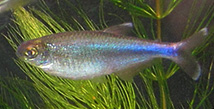
Boehlkea fredcochui, also known as the Cochu's blue tetra is a species of characin. Its natural range is in the Amazon Basin. It is commonly kept as an aquarium fish.

Knodus borki is a species of characin endemic to Peru, where it is found in the vicinity of Iquitos. It is found in a freshwater environment within a benthopelagic depth range. This species is native to a tropical environment. It lives in the habitats of rivers, streams, and tributaries.
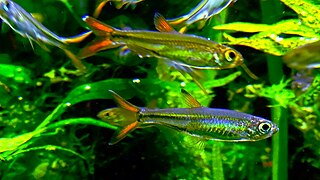
Ladigesia roloffi, the Sierra Leone dwarf characin, is a species of harmless African tetra that is found in Sierra Leone and Liberia, Africa. L. roloffi is the only member of its genus. The fish was named in honor of German aquarist Erhard Roloff (1903–1980), who collected the type specimen. They are a social species generally living in schools at mid depths and surface level fresh water. It lives for five years. Ninety-seven percent of their natural habitat has been lost.
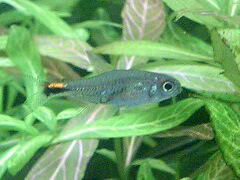
Axelrodia is a genus of small characin from the Amazon Basin and Meta River in South America, with three currently described species:

The royal tetra is a species of characin endemic to Brazil, where it is found in tributaries of the Aripuanã River. It was once the sole member of its genus.
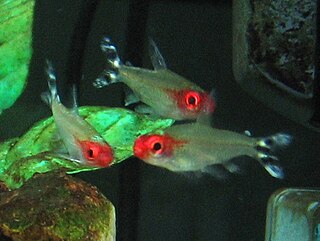
Petitella bleheri is a species of characin found in Amazon Basin in Brazil and Peru. It is one of three species commonly referred to as the rummy-nose tetra, and is also known as the firehead tetra.
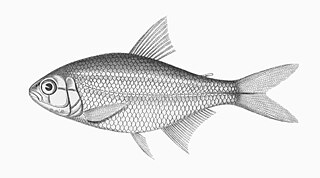
Astyanax argentatus is a small freshwater fish native to northern Central America and southern North America. Given its native range, it is also known as the Texan tetra. Little has been published regarding the feeding habits or behavior of A. argentatus, but it is known to have the northernmost distribution of any member of the genus Astyanax.

Astyanax aeneus, the banded tetra, is a small species of fish native to southern Central America and northern South America. It can be found in a variety of environments, including lakes, rivers, ponds, and slightly brackish locales like lagoons. As well as a varied habitat, it has a varied omnivorous diet: algae, seeds, leaves, insects, and fish fry appear to be the most common.

Astyanax angustifrons, sometimes referred to as the Campeche tetra, is a small freshwater fish from the rivers of Central and South America. It has a healthy distribution across southern Mexico and northern Guatemala, and is relatively common within its native range. Details regarding its diet and behavior are sparse, but it lives in areas with plentiful riparian vegetation, and most other members of the genus are omnivorous. Its habitat includes places affected by pollution and human activity; nonetheless, it is not endangered.
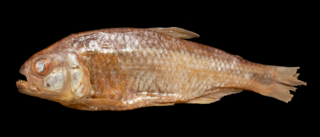
Astyanax brevimanus, sometimes referred to as the Quiché tetra, is a small species of freshwater fish native to various locales in Guatemala. Its native range is somewhat restricted, but it is a populous and adaptable species, so there is no risk of it going extinct anytime soon. It is unknown what A. brevimanus eats, or what specific habitats it prefers; current information is largely in the form of physical descriptions, general areas of occurrence, and hypotheses regarding relationships to congeners. Its silvery scales, indistinct humeral (shoulder) spot, and dark caudal-peduncle spot are features not unusual in species of Astyanax.

Astyanax caballeroi is a small species of freshwater fish endemic to a single lake system in Mexico. It has a longer snout and more slender body than most other species in the genus Astyanax, thought to be the result of predatory behavior; while A. caballeroi eats invertebrates and smaller fish, other Astyanax species are more broadly omnivorous, and have deeper bodies with shorter snouts. This difference in body shape once placed A. caballeroi, along with several other species of Astyanax, into the former genus Bramocharax.



















